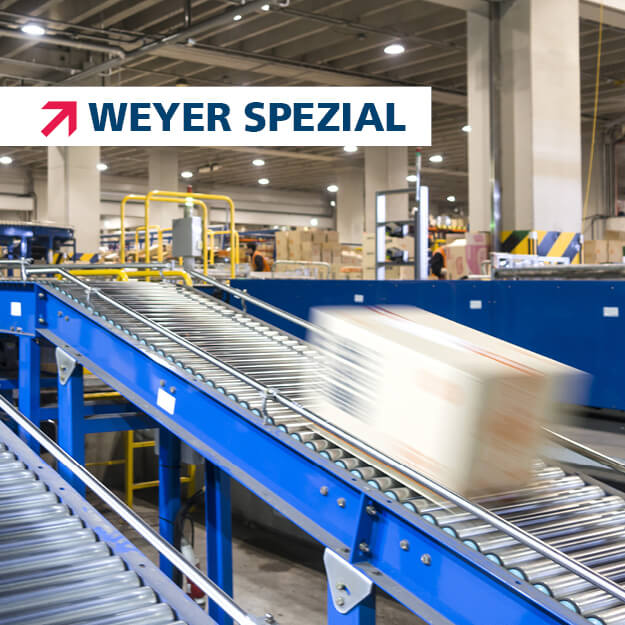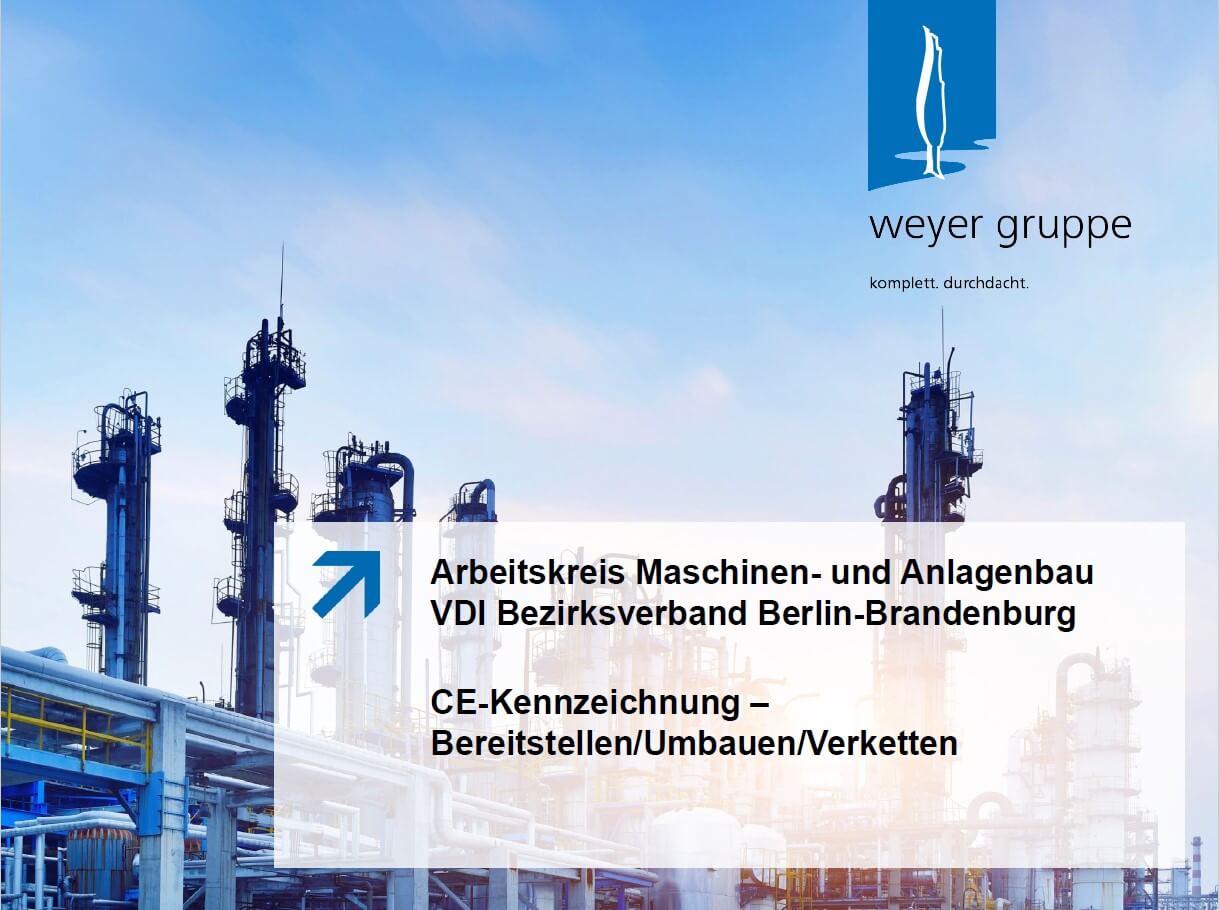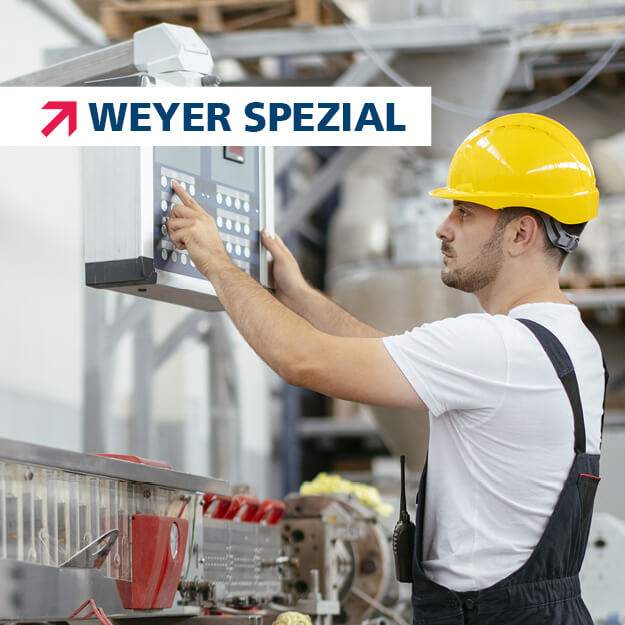The Machinery Directive 2006/42/EC (MD) defines the prerequisites under which machinery and partly completed machinery may be made available on the market or put into operation for the first time in the European Economic Area (EEA). In principle, the MD is intended for the manufacturer. Due to the linking of (incomplete) machines with a superordinate control system to form a plant or due to modifications to machines or plants after they have been put into operation, operators frequently also become so-called “self-manufacturers” in practice. Depending on the case, the manufacturer or own manufacturer must affix the CE marking and draw up technical documentation, in particular the documents, for partly completed machinery or for machinery before it is made available on the market or put into service and, where appropriate, before it is put into service:
- Risk assessment
- Assembly or operating instructions
- Declaration of incorporation or EU / EC declaration of conformity
The Machinery Directive (MD) is also applicable to large industrial plants (e.g. those in the chemical industry). These installations can usually be divided into individual functional units related to production and safety, for each of which the requirements of the MRL must be complied with.
Services
CE coordination
- Contract design within the procurement process
- Research into guidelines and standards
- Evaluation of supplier documentation
- Product classification
Documentation
- Carrying out/facilitating risk assessments (including with MBT-RAT)
- Templates for assembly and operating instructions
- Preparation of EU / EC declarations of conformity / declarations of incorporation
- Expert opinions on the interlinking of machinery
- Evaluation of modifications regarding a “significant change”
- Verification of the safety features and mathematical validation of the performance level (PL)
Training
- Fundamentals of the Machinery Directive
- Fundamentals of risk assessment (including MBT-RAT)
- Mathematical validation of the performance level (PL) with the SISTEMA software
The weyer group advises and supports you in the implementation of the formal requirements of the MRL for your machine or plant.
Years of experience
Risk assessments prepared
individual consultations
weyer special: Machine Control
EN ISO 13849-1 specifies the general control technology requirements of the EC Machinery Directive in the field of the machinery industry and provides safety requirements as well as a guideline for the principles of design and integration of safety-related parts of control systems.

weyer special: Machinery Directive
The Machinery Directive (MRL) describes uniform statutory health and safety requirements for the European Economic Area (EEA) that must be observed in the design and construction of machinery, partly completed machinery and products assimilated to machinery… DOWNLOAD WEYER SPECIAL

Machinery and Plant Engineering Working Group: VDI Bezirksverband Berlin-Brandenburg CE Marking – Provisioning/Remodelling/Catenation
Frequently asked questions in the field of CE marking according to the Machinery Directive
The MRL only applies within the European Economic Area (EEA). The EEA is made up of the 27 member states of the European Union and the EFTA states Iceland, Liechtenstein and Norway. On the basis of special agreements with the EU, the MRL is also applicable in Switzerland and Turkey.
The MRL regulates the following products (details in mouseover):
The MRL is basically addressed to the manufacturer who makes a product covered by the scope available on the market (places it on the market) for the first time in the EEA.
A special feature of the MRL is the equation of an operator with the manufacturer if the operator manufactures a machine for his own use and puts it into operation for the first time (operator = own manufacturer).
The requirements of the MRL must be fulfilled for the proprietary manufacturer by the time of commissioning. Commissioning is defined as the first intended useof a machine in the EEA.
Before placing a machine on the market or putting it into service, the manufacturer or his own manufacturer must provide evidence that the provisions of the MRL have been complied with. The MRL prescribes certain procedures for this purpose.
The MRL recognises three different conformity assessment procedures.
1. assessment of conformity with internal production control
In this procedure, the manufacturer or proprietary manufacturer must ensure and declare on his own responsibility that the machine meets all relevant legal requirements.
2. EC type-examination
EC type-examination is the procedure whereby a notified body ascertains and certifies that a representative specimen of machinery referred to in Annex IV satisfies the provisions of the MRL.
3. comprehensive quality assurance
As an alternative to the EC type-examination procedure, the conformity of machinery referred to in Annex IV shall be demonstrated by a full quality assurance system. The quality system shall be assessed, approved and monitored in operation by a notified body.
In connection with the implementation of the conformity assessment procedure, technical documentation must be drawn up by the manufacturer or own manufacturer. On the basis of the technical documentation, it must be possible for the competent authorities (market surveillance) to assess conformity with the legal requirements.
In particular, the following documents shall be prepared as part of the technical documentation:
- Risk assessment
- Operating instructions
- EU/EC Declaration of Conformity
Infringements of compliance with the internal market regulations can be objected to or sanctioned by the market surveillance / market monitoring.
The powers of the market surveillance authorities are determined nationally by the respective Member States in the EEA. In Germany, the market surveillance authorities are authorised according to the regulations in the Product Safety Act, among others:
- prohibit the display of a product
- order that a product be verified by a notified body
- prohibit a product from being made available on the market
- order the withdrawal or recall of a product made available on the market
- to secure a product, to destroy this product or to render it unusable in any other way
In the practical application of the term “assembly of machinery”, the question often arises in the case of large industrial plants (e.g. steelworks, power plants or plants of the chemical industry) as to what extent such plants are subject to the requirements of the MRL as “assembly of machinery”.
In the case of large industrial plants, the production-related connection can often be affirmed, but usually not the safety-related connection. In this case, such installations as a whole are notsubject to the requirements of the MRL.
The facts regarding the application of the MRL to industrial plant are referred to in the European Commission’s “Guide to the application of the Machinery Directive 2006/42/EC”, which states that the definition “assembly of machinery” does not necessarily have to be applied to a complete industrial plant in its entirety.
However, it is pointed out that most industrial installations can usually be divided into individual units of machinery in the sense of homogeneous functional units, for each of which the requirements of the MRL are to be applied.
Examples:
Raw material unloading and feeding, filling, processing, packaging and loading units
Practical example of planning an agitator system:
An operator is planning a new agitator system for his own use, consisting of an agitator vessel (1), pump (2), power-operated fittings (3+4), piping, control system incl. MSR technology (5) and a storage vessel (6). The assemblies are procured from various suppliers and interlinked under the responsibility of the operator.

Der CEKO sollte bereits in der Planungs-/Beschaffungsphase des Rührwerkssystems eingebunden werden, um die folgenden Fragen zu klären:
- Are the partly completed machines (1) to (4) interlinked with the storage container (6), the pipelines and the control system incl. MSR technology (5) in terms of production andsafety?
- What are the resulting requirements for the assessment procedure according to the MRL and is CE marking required in this context?
- Do other EU directives apply beyond the MRL, e.g. for pressure equipment 2014/68/EU, equipment in potentially explosive atmospheres 2014/34/EU and for electromagnetic compatibility 2014/30/EU?
- Which documents must be prepared in this context for the “agitator system in its entirety or for the individual machines?
- Which CE-relevant aspects are to be contractually regulated in the procurement process vis-à-vis the suppliers for the assemblies (1) to (6) (e.g. with regard to responsibilities, interface considerations and the documentation to be provided)?
- Was the documentation provided by the suppliers checked for compliance with the formal legal requirements before initial commissioning (plausibility check)?
When planning the agitator system, other practical aspects must also be taken into account, e.g.:
- Consideration of the interfaces and interactions should also begin in the planning phase of the plant, e.g. with regard to measures for explosion protection (explosion protection concept) as the basis for the explosion protection document in accordance with the Ordinance on Hazardous Substances and the definition of safety functions with classification of the required performance level (PL) or safety integrity level (SIL) for the execution of the control technology chain of action sensor-logic-actuator.
- In order to ensure that a large number of hazards are identified in the risk assessment, the risk assessment should be supplemented with a systematic consideration of aspects of process safety in the form of a HAZOP study (PAAG method) for process and process engineering installations, taking into account the protection goals from Annex I of the MRL.
- The risk assessment prepared in accordance with the MRL can be used by the operator as employer, among other things, to fulfil the legal requirements for occupational safety as part of the work equipment-related risk assessment in accordance with the Ordinance on Industrial Safety and Health.
For the use of work equipment (e.g. machines/plants) by the operator, the Occupational Health and Safety Act and the Ordinance on Industrial Safety and Health (BetrSichV) based on it must be observed, among other things.
The BetrSichV stipulates that before modifying work equipment, the employer must assess whether the modifications require compliance with manufacturer’s obligations arising from other legal provisions, in particular the Product Safety Act (ProdSG).
The ProdSG covers the making available of products on the market, irrespective of whether they are new, used, repaired, reconditioned or even substantially modified. The ProdSG defines that a used product that is “substantially changed” from its original condition is to be considered a new product.
The assessment of whether a significant change within the meaning of the ProdSG is present must be examined on a case-by-case basis within the framework of a risk assessment, taking into account the interpretation in the interpretation paper of the Federal Ministry of Labour and Social Affairs with the flow chart mentioned below.
The PL is a characteristic value for the reliability with which safety-relevant parts of a control system fulfil a safety function – for personal protection. It is defined as the probability of a dangerous failure per hour (PFH). The PL is represented on a five-point scale from a to e, where e stands for the lowest probability of failure.
In the risk assessment according to MRL, the required performance level (PLr) must first be defined as a reliability requirement for each safety function that is to be implemented as a technical protective device in the machine control system for risk reduction, according to a risk graph or standard specifications.
The PLr refers to the control technology part of the protective device (functional chain) consists of the sensor system for detecting the dangerous state, a logic system for processing the signals and an actuator system for switching off the dangerous machine movement.
The specified PLr thus has an impact on the quality of components used in the functional chain and on the design of the circuitry in terms of susceptibility to one or more faults.
In the next step, the reliability of the respective safety function must be evaluated and mathematically proven, taking into account the device- and component-specific characteristics used. Proof is provided by determining the category, the probability of a dangerous failure per hour and determining the diagnostic coverage.
For the verification, the component suppliers either directly provide the data on the probability of failure and/or the PL of their subsystems or provide information on the number of operations until a dangerous failure occurs. For proven components without supplier details, default values from standard tables can be used.
In the process, the individual subsystems are linked together to determine the PL achieved for the overall system. The probability of failure and the diagnostic coverage of the overall system are calculated from the parameters of the subsystems and assigned to a PL for the overall system of the safety function according to standard tables.
The last step is to verify whether the PL achieved is greater than or equal to the required PLr.




